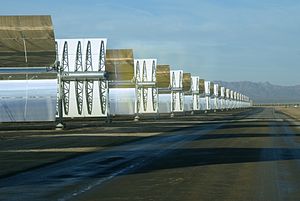The Genesis Solar Energy Project is a concentrated solar power station located in the Mojave Desert on 1,920 acres (780 ha) of Bureau of Land Management land, in eastern Riverside County, California. The plant is owned/managed by Genesis Solar, LLC, a subsidiary of NextEra Energy Resources, LLC. The Genesis Solar Energy Project is located about 25 miles (40 km) west of Blythe, in the Lower Colorado River Valley.[4] The plant was built in the Colorado Desert along an ancient trade route that native people had traveled for thousands of years. The route traversed the Sonoran Desert and enabled trade between the Colorado River and the coast.[5][6]
| Genesis Solar Energy Project | |
|---|---|
 | |
 | |
| Country | United States |
| Location | Riverside County, California |
| Coordinates | 33°39′54″N 114°59′41″W / 33.66500°N 114.99472°W |
| Status | Operational |
| Construction began | December 15, 2010 |
| Commission date | April 24, 2014[1] |
| Construction cost | US$1.25 billion[2] |
| Owner(s) | NextEra Energy Partners |
| Operator(s) | NextEra Energy Resources |
| Solar farm | |
| Type | CSP |
| CSP technology | Parabolic trough |
| Collectors | 500,000 |
| Site area | 1,920 acres (780 ha) |
| Power generation | |
| Units operational | 2 x 140 MWe (gross) |
| Nameplate capacity | 250 MW[3] |
| Capacity factor | 28.32% (2016-2020) |
| Annual net output | 620 GW·h |
The solar power plant consists of two independent 125 MW net (140 MW gross) sections, using solar trough technology.[7] This was one of three of the world's largest solar plants, that began supplying power in 2013 and 2014, located in the deserts of Riverside and San Bernardino counties.[8] The Project power block and solar arrays occupy about 1,360 acres (550 ha) of the site. The rest are the evaporation ponds, access road, administration buildings and some fenced open area. The 1840 Solar Collector Assemblies are 1,048 square metres (11,280 sq ft) each, yielding 1,928,320 square metres (20,756,300 sq ft) of total solar aperture.
A June 2014 report details the project's potential impact on bird populations.[9]
Production
Genesis Solar Energy Project's production is as follows (MWh).[10]
| Year | Jan | Feb | Mar | Apr | May | Jun | Jul | Aug | Sep | Oct | Nov | Dec | Total |
|---|---|---|---|---|---|---|---|---|---|---|---|---|---|
| 2013 | 345 | 6,684 | 7,029 | ||||||||||
| 2014 | 4,892 | 13,080 | 48,455 | 60,960 | 72,621 | 80,979 | 68,861 | 66,969 | 63,976 | 46,236 | 35,271 | 13,813 | 576,113 |
| 2015 | 16,876 | 40,980 | 60,875 | 70,919 | 72,725 | 70,898 | 70,190 | 69,009 | 52,732 | 41,160 | 33,601 | 21,489 | 621,454 |
| 2016 | 17,573 | 45,940 | 55,704 | 55,737 | 79,177 | 76,282 | 77,787 | 67,890 | 58,971 | 48,245 | 30,618 | 10,218 | 624,142 |
| 2017 | 21,248 | 28,112 | 62,031 | 64,575 | 75,992 | 83,297 | 68,336 | 68,704 | 62,515 | 55,708 | 22,099 | 16,214 | 627,831 |
| 2018 | 24,000 | 37,452 | 50,348 | 63,379 | 79,074 | 80,337 | 65,787 | 67,571 | 67,820 | 43,918 | 29,755 | 13,701 | 623,142 |
| 2019 | 21,504 | 32,737 | 49,442 | 64,304 | 71,059 | 76,978 | 70,784 | 73,918 | 60,203 | 56,903 | 26,794 | 12,417 | 617,043 |
| 2020 | 18,874 | 34,184 | 46,428 | 68,153 | 82,837 | 78,973 | 82,897 | 64,037 | 50,644 | 46,579 | 29,435 | 6,088 | 609,129 |
| 2021 | 1,905 | 16,631 | 55,797 | 66,672 | 78,899 | 67,839 | 55,492 | 62,516 | 52,333 | 42,882 | 27,358 | 10,283 | 538,607 |
| 2022 | 22,275 | 37,730 | 55,671 | 68,625 | 80,949 | 78,285 | 62,529 | 57,542 | 50,694 | 50,523 | 31,068 | 17,816 | 613,707 |
| 2023 | 13,879 | 32,899 | 40,676 | 70,312 | 79,404 | 82,249 | 73,300 | 64,977 | 59,064 | 53,893 | 29,489 | 18,042 | 618,184 |
| Total (2013-2023) | 6,070,352 | ||||||||||||
Maximum production was estimated at 580,000 MW·h per year.[11]
See also
References
External links
- Nexteraenergyresources.com: Genesis Solar Energy Project — (redesign factsheet)
